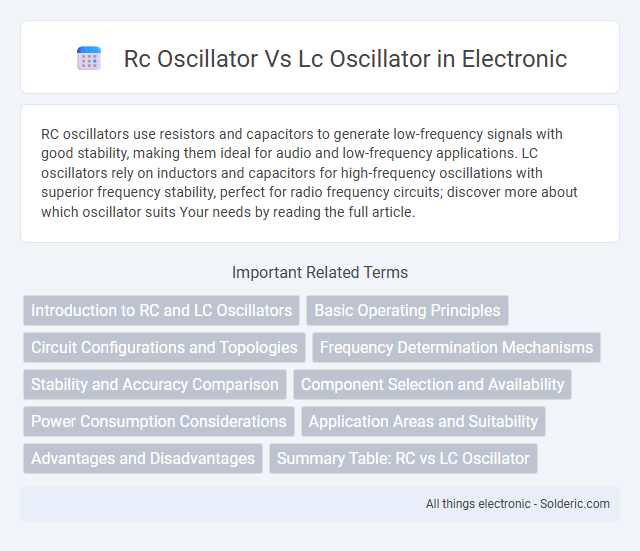RC oscillators use resistors and capacitors to generate low-frequency signals with good stability, making them ideal for audio and low-frequency applications. LC oscillators rely on inductors and capacitors for high-frequency oscillations with superior frequency stability, perfect for radio frequency circuits; discover more about which oscillator suits Your needs by reading the full article.
Comparison Table
| Feature | RC Oscillator | LC Oscillator |
|---|---|---|
| Frequency Range | Low to medium frequency (up to MHz) | High frequency (up to GHz) |
| Frequency Stability | Moderate stability | High stability |
| Components | Resistor and capacitor | Inductor and capacitor |
| Size | Compact, fewer components | Larger due to inductors |
| Power Consumption | Lower power consumption | Higher power consumption |
| Applications | Audio oscillators, low-frequency signal generators | Radio transmitters, high-frequency clocks |
| Complexity | Simple circuit design | More complex design |
| Tuning | Easier frequency adjustment | Less flexible, requires variable inductors or capacitors |
Introduction to RC and LC Oscillators
RC oscillators use resistors and capacitors to generate low-frequency sinusoidal signals, ideal for audio and low MHz applications. LC oscillators rely on inductors and capacitors to produce high-frequency oscillations, commonly employed in radio frequency circuits. The choice between RC and LC oscillators depends on factors like frequency stability, tuning range, and component size.
Basic Operating Principles
RC oscillators generate oscillations using resistor-capacitor networks that create phase shifts to sustain signal feedback, typically producing low-frequency waveforms ideal for audio and timing circuits. LC oscillators rely on the resonance between inductors and capacitors, forming a tank circuit that enables high-frequency oscillations suitable for RF and communication applications. Your choice depends on the frequency range and stability requirements, as LC oscillators offer better frequency precision, while RC oscillators excel in simplicity and ease of integration.
Circuit Configurations and Topologies
RC oscillators utilize resistor-capacitor networks in configurations such as Wien bridge, phase-shift, or twin-T topologies to produce low-frequency sine waves with stable amplitude. LC oscillators rely on inductor-capacitor tank circuits, commonly implemented in Colpitts, Hartley, or Clapp topologies, to generate high-frequency oscillations with high quality factors (Q). The choice of RC or LC circuit configuration significantly influences frequency stability, signal purity, and application suitability in oscillator design.
Frequency Determination Mechanisms
RC oscillators determine frequency using resistors and capacitors, where the time constant of the RC network sets the oscillation rate, typically offering lower frequency ranges suitable for audio and low-frequency applications. LC oscillators rely on an inductor-capacitor tank circuit, where the resonance frequency depends on the inductance and capacitance values, enabling higher frequency oscillations commonly used in RF and microwave circuits. Your choice between RC and LC oscillators depends on the desired frequency stability, tuning precision, and application frequency range.
Stability and Accuracy Comparison
LC oscillators offer superior frequency stability and accuracy due to their reliance on high-Q inductors and capacitors, which minimize energy loss and frequency drift. RC oscillators, while simpler and cheaper, tend to exhibit lower stability and accuracy because their resistors and capacitors are more susceptible to temperature variations and component tolerance changes. Your choice between an RC and LC oscillator hinges on the required precision and environmental conditions of your application.
Component Selection and Availability
RC oscillators primarily use resistors and capacitors, which are widely available, cost-effective, and offer easier component selection for a variety of frequency ranges. LC oscillators require high-quality inductors and capacitors; inductors are often bulkier, more expensive, and may introduce parasitic losses, making component selection more critical for achieving stable oscillation. The availability of precision inductors can be limited compared to standard resistors and capacitors, impacting the design constraints and overall oscillator performance.
Power Consumption Considerations
RC oscillators typically consume less power due to their simpler circuitry relying on resistors and capacitors, making them ideal for low-power applications. LC oscillators generally have higher power consumption because of the active components sustaining oscillations through inductors and capacitors. Power efficiency in RC oscillators suits battery-operated devices, while LC oscillators prioritize frequency stability despite increased power usage.
Application Areas and Suitability
RC oscillators excel in low-frequency applications such as audio signal generation, clock generation in digital circuits, and waveform generation where stability requirements are moderate. LC oscillators are preferred in high-frequency applications like RF signal generation, radio transmitters, and frequency synthesizers due to their superior frequency stability and higher Q-factor. Selection depends on frequency range, stability needs, and power consumption constraints in the specific application area.
Advantages and Disadvantages
RC oscillators offer simpler circuits and are cost-effective for generating low-frequency signals but suffer from lower frequency stability and higher phase noise compared to LC oscillators. LC oscillators provide better frequency stability and higher Q factor, making them suitable for high-frequency applications, though they are generally more complex and expensive to implement. Selection between RC and LC oscillators depends on the required frequency range, stability, and cost constraints in the specific electronic design.
Summary Table: RC vs LC Oscillator
RC oscillators use resistors and capacitors to produce low-frequency signals typically below 1 MHz, offering simplicity and stability in audio applications. LC oscillators utilize inductors and capacitors to generate high-frequency signals often ranging from 1 MHz to several GHz, favored for RF circuits due to superior frequency stability and signal purity. Compared in a summary table, RC oscillators excel in low-frequency, low-cost, and ease of integration, while LC oscillators dominate in high-frequency, better waveform quality, and sharp frequency selectivity.
rc oscillator vs lc oscillator Infographic

 solderic.com
solderic.com